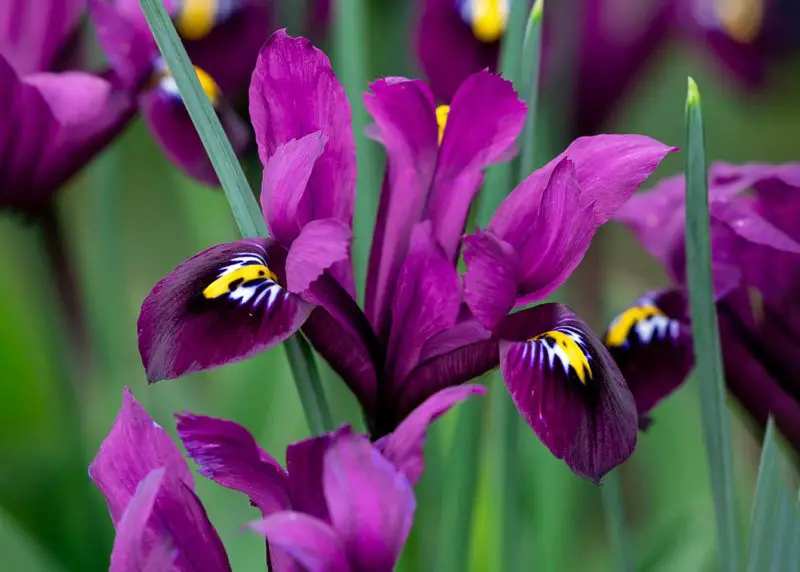Irises are among the most captivating flowers in any garden, known for their vivid colors, intricate shapes, and elegant presence. With over 300 species and countless hybrids, iris plants have enchanted gardeners for centuries. Whether you’re planting bearded irises, Siberian irises, or Louisiana irises, each type offers something unique to your garden.
This most detailed guide will walk you through every essential aspect of iris plant care and growing tips to help you achieve vibrant blooms and healthy plants.
Understanding Iris Plants

What is an Iris Plant?
An iris plant is a striking and versatile perennial flower that belongs to the Iridaceae family. The name “iris” originates from Greek mythology, where Iris was the goddess of the rainbow, acting as a messenger between heaven and earth. This mythological association feels especially fitting since iris flowers appear in a dazzling range of colors, from soft whites and pastel pinks to deep purples, rich blues, and even bright yellows. Their unique beauty has made them a favorite in gardens across many regions.
Depending on the species, iris plants can grow either from thickened underground stems called rhizomes or from bulbs. Rhizomatous irises typically spread horizontally, producing new shoots along the surface of the soil, while bulbous varieties grow in more compact clusters and often bloom earlier in the season. Irises are admired not only for their wide palette of hues but also for their elegant, sword-like foliage and distinctive flower structure, which features three upright petals (standards) and three drooping ones (falls).
Iris flowers are not just appreciated for their looks—they also serve practical roles in landscapes. Many varieties are drought-tolerant once established, and some can thrive in wet or boggy soils, making them suitable for different garden conditions. With the right planting site and care, iris plants can return year after year, putting on a spectacular floral show each spring or early summer.
Common Types of Iris Plants
Iris plants are generally categorized into three main groups based on their structure and growth habits. Each group has distinct characteristics and growing preferences, making it easier for gardeners to choose the right type for their specific conditions.
-
Bearded Irises are the most recognizable and widely grown type. They are named for the fuzzy “beard” that runs down the center of each fall petal, giving the flower a textured and ornamental look. These irises grow from rhizomes and prefer full sun with well-drained soil. They are available in a dazzling array of colors and are often used in traditional garden beds and borders.
-
Beardless Irises include well-known varieties such as Siberian, Japanese, and Louisiana irises. These irises do not have the characteristic beard on their falls, giving them a sleeker and often more refined appearance. They generally prefer slightly moist soil, and some, like the Louisiana iris, thrive in wet or boggy conditions. Their graceful form and tolerance for a variety of environments make them popular in naturalistic and water garden settings.
-
Bulbous Irises grow from bulbs rather than rhizomes and include types like Dutch irises and reticulated irises. These tend to bloom earlier in the season and are often shorter-lived perennials, though they return reliably each year if cared for properly. Dutch irises are frequently seen in cut flower arrangements, while reticulated irises are compact and ideal for rock gardens or container displays.
While the care needs of each group vary slightly, all irises benefit from well-prepared soil, good drainage, and occasional division to prevent overcrowding. Choosing the right type depends on your climate, soil conditions, and desired aesthetic.
Iris Growing Conditions
Ideal Climate and Hardiness Zones
Iris plants are remarkably versatile and can adapt to a range of climates, making them a favorite among gardeners in various regions. Most iris species flourish in USDA hardiness zones 3 through 10, though specific preferences vary by type. Bearded irises, known for their showy blooms and robust growth, perform particularly well in temperate zones and can withstand freezing winters with ease. They require a period of dormancy induced by cooler temperatures, which helps promote healthy flowering in the following season.
In contrast, Louisiana irises thrive in warmer, humid environments and are better suited to zones with mild winters and moist conditions. These irises can tolerate wet soils, making them excellent candidates for rain gardens or planting near ponds. Other types, such as Dutch irises, are commonly grown as annuals or re-planted each year in colder zones due to their sensitivity to frost. Understanding your local climate helps ensure long-lasting, vigorous growth regardless of the iris variety.
Whether planted in northern or southern climates, irises generally prefer distinct seasonal changes that support both blooming and dormancy. By choosing the appropriate species for your region’s zone, you can enjoy reliable flowering year after year with minimal intervention.
Sunlight Requirements
Sunlight plays a critical role in the health and blooming capacity of iris plants. Most irises require full sun to thrive, ideally receiving at least six hours of direct sunlight each day. Exposure to sufficient light ensures the development of strong flower stalks and vibrant, colorful blooms. When planted in too much shade, irises may become leggy, produce fewer flowers, or suffer from fungal issues due to excess moisture retention.
Bearded irises, in particular, demand full sun to maintain their bold form and vigorous flowering. In cooler regions, all-day sun exposure is ideal, while in hotter climates, a bit of protection from intense afternoon sun can help reduce stress on the plants. Partial shade may be tolerated by some beardless varieties, such as Japanese irises, but even these benefit from morning light or dappled sun during the day.
Planting irises in an open location with good air movement also contributes to their overall health. Sun-drenched spots with free-flowing air help prevent leaf diseases and promote faster drying after rain or irrigation.
Soil Type and Drainage
The health and longevity of iris plants are closely tied to the quality and condition of the soil in which they are planted. Well-drained soil is essential, especially for rhizomatous irises like bearded varieties, which are particularly prone to rot in soggy or compacted earth. Ideally, the soil should be light and loose, allowing water to pass through easily while still holding enough moisture for root uptake.
A slightly acidic to neutral pH, ranging from 6.0 to 7.0, supports optimal nutrient absorption. Mixing compost or well-aged organic matter into the soil can enhance fertility and texture, providing a more balanced environment for root development. Raised beds or naturally sandy soils are especially beneficial in areas with heavy clay, helping prevent water accumulation around the rhizomes or bulbs.
When planting irises, it’s important to position rhizomes just below the soil surface or even slightly exposed, especially for bearded types. This encourages air circulation around the base and reduces the risk of rot. Regular monitoring for soggy patches or pooling water will help maintain soil health and keep your iris plants blooming season after season.
How to Plant Iris Plants
When to Plant Irises
Timing is essential when planting irises to ensure they establish well and bloom beautifully in the coming season. For rhizomatous varieties, the ideal planting window falls between late summer and early fall, typically from July through September. This period gives the plants ample time to grow roots before colder weather arrives. In regions with harsh winters, earlier planting within this range is often recommended to give the rhizomes a head start before the first frost.
Bulbous irises, such as Dutch or reticulated types, are best planted in the fall, several weeks before the ground begins to freeze. This allows the bulbs to undergo a necessary chilling period, which is crucial for healthy spring blooms. Avoid planting irises in spring, as they may not have enough time to establish themselves before hot weather arrives, potentially stalling growth and reducing flowering.
By aligning planting times with seasonal cues, gardeners can encourage stronger root development and more vigorous flowering the following year. Patience and planning are key when working with irises, as well-established plants often reward gardeners with increasingly robust displays over time.
Planting Iris Rhizomes
To plant iris rhizomes successfully, begin by selecting a site that receives full sun and has excellent drainage. Clear the area of weeds and loosen the soil to a depth of about 12 inches. Mixing in compost or aged organic matter at this stage will enrich the soil and improve texture. Good soil preparation sets the foundation for strong root growth and disease resistance.
Once the soil is ready, form a small mound at the center of each planting hole. Place the rhizome directly on top of this mound, spreading the roots gently down along the sides. The rhizome itself should remain partially exposed, with just a light layer of soil covering the sides and roots. This exposure is especially important for bearded irises, which are prone to rot if buried too deeply. After positioning the rhizome, water the area lightly to help settle the soil and remove any air pockets.
Planting irises in this manner promotes proper airflow and helps the plants anchor themselves securely. It’s important not to overwater newly planted irises, as they prefer slightly dry conditions during the early establishment phase. Once new growth appears, regular watering can be gradually increased.
Spacing Requirements
Proper spacing between iris plants is crucial for maintaining healthy growth and preventing the spread of disease. Each plant should be spaced approximately 12 to 24 inches apart, depending on the variety and expected mature size. This spacing provides room for the rhizomes or bulbs to expand over time and supports good air circulation between plants.
Good airflow reduces the risk of fungal problems such as leaf spot or rhizome rot, especially in humid or wet climates. Crowding can also lead to stunted growth and reduced blooming, as the plants compete for nutrients, sunlight, and moisture. When planting in rows or mass groupings, consider the direction of prevailing winds and sunlight to ensure all parts of the bed receive adequate exposure.
Over the years, iris clumps will naturally expand. Regular division every three to four years not only revitalizes older plants but also helps preserve spacing and keeps the planting area tidy and productive.
Watering and Feeding
Watering Schedule
Iris plants are well-regarded for their resilience and ability to withstand dry periods, especially once they are fully established. However, they do benefit from a consistent watering routine during the active growing season, particularly in spring and early summer when they are developing flower stalks and foliage. Deep watering once or twice a week is generally sufficient, but the frequency may vary depending on local weather patterns and soil drainage.
During periods of drought or high heat, irises may require additional watering to keep the roots hydrated and support blooming. It’s essential to allow the soil to dry slightly between watering sessions, as overly wet conditions can promote root rot, especially in clay-heavy or poorly drained soils. When irrigating, aim to water the soil directly rather than the leaves to minimize the risk of fungal issues.
In the weeks following planting, keep the soil evenly moist but never soggy. Once irises show signs of new growth, you can reduce watering slightly, allowing the plant to become more self-sufficient. Established irises need less frequent watering and can often thrive with natural rainfall alone, depending on the climate.
Fertilizing Irises
Feeding irises properly helps promote vibrant blooms and strong plant structure throughout the growing season. The best time to apply fertilizer is in early spring when new foliage begins to emerge. A second application can be made about a month after the plants finish blooming, which encourages healthy root development and prepares the plant for the next flowering cycle.
Choose a balanced, low-nitrogen fertilizer—typically one with a ratio such as 5-10-10 or 6-10-10. These formulations support flower and root growth without encouraging too much leafy foliage, which can become susceptible to rot and disease. Avoid high-nitrogen fertilizers, as they often lead to lush but weak foliage and minimal blooms.
Apply the fertilizer around the base of the plant, keeping it a few inches away from the rhizomes to prevent burning. Lightly work it into the soil and water thoroughly to help nutrients reach the root zone. With consistent feeding and proper timing, irises will reward you with strong stems and vibrant, long-lasting flowers.
Iris Maintenance and Pruning
Deadheading Spent Flowers
Regular deadheading plays an important role in maintaining the health and appearance of iris plants throughout the blooming season. As individual flowers begin to fade, they should be carefully removed by snipping the spent bloom from the stalk. This simple step not only keeps the plant looking tidy but also encourages more blooms by preventing the plant from diverting energy into seed production.
By focusing energy back into the rhizome instead of seed development, the plant is better prepared for robust growth and flowering the following year. Deadheading also minimizes the risk of fungal infections, as decaying petals can attract moisture and pests. While the entire flower stalk can be removed once all blooms have finished, avoid damaging the healthy foliage in the process.
For bulbous iris varieties that do not rebloom, removing the flower stem after blooming has finished is still beneficial. It supports plant energy conservation and maintains an orderly garden appearance as the foliage continues to grow and gather nutrients.
Cutting Back Foliage
Proper pruning at the end of the growing season is essential for long-term iris health. In late fall, once the leaves begin to yellow and die back naturally, cut the foliage down to approximately six inches above ground level. This helps prevent overwintering pests and fungal diseases that can linger in dying leaves and affect the plant’s performance in the spring.
It’s important not to cut back green foliage prematurely. As long as the leaves are green, they are actively photosynthesizing and contributing energy to the rhizome or bulb. Premature trimming can weaken the plant and reduce its ability to bloom the following season. Instead, wait until the leaves have fully faded and begun to dry before performing any major pruning.
Clearing away the trimmed leaves and disposing of them—rather than composting—can further reduce the risk of spreading disease. A tidy winter bed also makes spring cleanup easier and promotes quicker emergence of healthy new growth.
Dividing Iris Clumps
Over time, iris clumps can become overcrowded, leading to reduced flowering and increased susceptibility to disease. Dividing the plants every three to five years is one of the best ways to rejuvenate their growth and maintain strong bloom production. The ideal time to divide irises is in late summer, after the flowering season and once the foliage has started to decline.
To divide, dig up the entire clump carefully with a spade or garden fork, taking care not to damage the rhizomes. Shake off excess soil and examine the rhizomes for signs of health. Discard any old, woody, or diseased segments, and separate the newer, firm rhizomes with healthy roots and at least one fan of leaves. These are the best candidates for replanting.
Trim the leaves of the divided rhizomes to about six inches and replant them following standard planting guidelines.
Common Pests and Diseases
Iris Borer
Among the most serious threats to iris plants is the iris borer, a larval pest that can cause extensive damage if left unchecked. These caterpillars hatch in early spring and begin by chewing through iris leaves before tunneling into the rhizomes. As they feed inside the plant, they create entry points for bacterial soft rot, leading to mushy, foul-smelling rhizomes and, eventually, plant collapse.
Early signs of iris borer infestation include notched or water-soaked streaks in the foliage. As the damage progresses, the leaves may turn yellow and wilt, and the rhizomes become soft and discolored. Immediate action is necessary to prevent spread. Infected rhizomes should be removed and destroyed, not composted, to eliminate any lingering larvae. Preventative insecticide treatments applied in early spring, when the larvae first emerge, can also help protect healthy plants.
Maintaining clean garden beds by removing dead foliage in the fall reduces overwintering borer eggs and helps break the pest’s life cycle. Regular inspection of leaves and rhizomes during the growing season can catch problems early before they escalate.
Fungal Infections
Irises are vulnerable to several fungal diseases, especially in humid or poorly ventilated environments. Common issues include leaf spot, which creates brown lesions on the foliage; botrytis blight, which causes gray mold on flowers and stems; and soft rot, often linked with iris borer damage. These conditions are often worsened by overcrowding, overhead watering, and excess moisture around the base of the plant.
To minimize fungal problems, plant irises with adequate spacing and in areas with good air circulation. Avoid watering late in the day or from above, as wet foliage provides ideal conditions for fungal spores to thrive. Promptly remove and discard any infected leaves or stems to reduce the risk of further spread.
In cases of persistent or severe infections, fungicidal sprays may be used as a last resort. Apply according to label instructions, and always combine chemical treatments with good cultural practices to enhance effectiveness and prevent recurrence.
Aphids and Thrips
While not typically fatal, aphids and thrips can weaken iris plants and diminish the quality of blooms. These tiny insects feed by sucking plant sap, leading to distorted growth, curling leaves, and blotchy or malformed flowers. Heavy infestations may also attract ants and encourage the development of sooty mold, a black fungus that feeds on insect secretions.
Monitoring the plants regularly during the growing season can help catch infestations early. At the first sign of these pests, rinse the affected areas with a strong stream of water or apply insecticidal soap or neem oil. These treatments are usually sufficient to control small populations without harming beneficial insects.
Encouraging natural predators such as ladybugs, lacewings, and parasitic wasps is another effective way to keep aphids and thrips in check. Creating a diverse, insect-friendly garden environment supports this natural balance and reduces the need for chemical interventions.
Overwintering Iris Plants
Winter Protection for Rhizomes
In regions where winters are harsh, protecting iris rhizomes from freezing temperatures is essential to ensure their survival and encourage healthy spring growth. After the first hard frost, apply a light mulch layer using materials like straw, pine needles, or shredded leaves. This helps insulate the soil and prevents the freeze-thaw cycles that can push rhizomes out of the ground or cause them to crack.
The mulch layer should not be too heavy or compacted, as excessive moisture retention can lead to rot. Choose breathable materials and avoid using bark or dense compost that may trap water around the rhizomes. As soon as winter starts to recede and the soil begins to thaw in early spring, gradually remove the mulch to allow new growth to emerge and prevent fungal issues associated with lingering dampness.
For iris varieties especially sensitive to cold, planting in raised beds or near structures that offer shelter can provide additional warmth and protection during the winter months.
Caring for Bulbous Irises
Bulbous iris varieties, such as Dutch or reticulated irises, require different care strategies depending on the climate. In colder regions where ground temperatures drop significantly, these bulbs should be dug up after flowering and once the foliage has yellowed. Carefully lift the bulbs, brush off excess soil, and store them in a cool, dry, and well-ventilated location until replanting in the fall.
Store the bulbs in paper bags, mesh sacks, or shallow trays with good air circulation to avoid mold or premature sprouting. Periodically check the stored bulbs throughout the winter and discard any that show signs of softness or decay.
In warmer climates with milder winters, bulbous irises can remain in the ground year-round without issue. To help them thrive, make sure the planting site offers excellent drainage and receives plenty of sunlight even during the cooler months. A light mulch layer may still be applied, though it should be removed early in the spring to promote healthy regrowth.
Propagation Methods
Dividing Rhizomes
Dividing rhizomes is the most common and effective method for propagating iris plants. The process involves carefully digging up mature iris clumps and separating them into individual rhizome sections, each with healthy roots and at least one fan of leaves. This method helps prevent overcrowding, rejuvenates the plant, and ensures better blooming in the following seasons.
To divide, dig around the iris clump, lift it out of the ground, and gently separate the rhizomes. Discard any old or damaged sections and replant only the healthy, firm rhizomes. After cutting the rhizomes, allow the sections to dry for 24 hours in a shaded, dry location to reduce the risk of rot when replanting. Once dried, replant the rhizomes in well-drained soil, following the typical planting instructions.
Dividing irises every 3 to 5 years promotes healthier plants with more robust blooms. Additionally, this method ensures that the irises maintain their vigor by preventing the buildup of pests or diseases in overly crowded areas.
Growing from Seed
While growing irises from seed is less common, it can be a rewarding but slower method of propagation. Iris seeds can be collected from mature flowers once they have fully bloomed and dried. To start the seeds, sow them in containers filled with well-draining soil and place them in a location that provides indirect light. Since iris seeds require cold stratification to break dormancy, the containers should be placed in a cold area, such as a refrigerator, for 6–8 weeks before being planted.
Once the stratification period is over, remove the seeds from the cold environment and sow them in fresh, moist soil. Be patient, as germination can take several months, and flowering from seed-grown irises may not occur for 2 to 3 years. While this method requires more time and effort compared to dividing rhizomes, it offers the opportunity to cultivate unique and genetically diverse iris plants.
This method is ideal for those looking to experiment with different iris varieties or for breeders interested in developing new types. However, it requires a long-term commitment and consistent care throughout the process.
Companion Planting with Irises
Best Companion Plants
Irises thrive in diverse garden settings, and selecting the right companion plants can enhance their beauty while promoting a healthy ecosystem. Pairing irises with compatible plants helps create visually stunning combinations, supports beneficial insects, and ensures a balanced garden environment. Here are some of the best companion plants for irises:
-
Peonies: Peonies offer a complementary contrast to the spiky, upright form of irises. Their large, rounded blooms provide a soft, lush backdrop that highlights the elegance of iris flowers. Both plants prefer similar growing conditions, such as full sun and well-drained soil, making them easy to care for together.
-
Daylilies: Daylilies are another excellent iris companion, known for their vibrant, showy flowers that bloom in various colors. Daylilies thrive in similar conditions to irises, and their foliage can provide a beautiful contrast to the narrow, sword-like leaves of irises. Additionally, their extended blooming period complements the relatively short bloom time of irises.
-
Lupines: Lupines are ideal companions for irises, with their tall, spiky flowers that provide vertical interest and complement the iris’s structure. Their bright, colorful blooms attract pollinators like bees and butterflies, which can help improve pollination for all plants in the garden. Lupines prefer similar soil conditions to irises, making them a harmonious choice for planting.
-
Salvia: Salvia is a hardy perennial with aromatic, colorful flowers that add vibrant splashes of purple, blue, and red to the garden. Its upright growth habit works well alongside irises, creating a visually appealing contrast. Salvia also attracts pollinators and deters some pests, benefiting irises and other nearby plants.
-
Alliums: The spherical blooms of alliums, such as the popular ornamental onion, provide a unique focal point when planted with irises. Their tall stems and striking flowers create a dramatic visual effect, especially when paired with irises of a similar height. Like irises, alliums thrive in full sun and well-drained soil, making them compatible companions.
These plants not only complement irises in terms of color, texture, and form but also help support the overall health of the garden by attracting pollinators and beneficial insects, promoting biodiversity, and improving soil conditions.
Plants to Avoid
While irises are adaptable and can thrive alongside many plants, there are certain types that should be avoided to ensure their optimal growth and health. Here are some plants that are best kept away from irises:
-
Aggressive Spreaders (e.g., Mint, Ground Covers): Plants like mint, creeping Jenny, or other ground covers that spread quickly can compete with irises for space, nutrients, and water. Their vigorous growth can overshadow the delicate rhizomes of irises, leading to overcrowding and reduced blooming. Mint, in particular, is notorious for its ability to spread uncontrollably, and its roots can easily choke out iris rhizomes.
-
Heavy Shade Plants: Irises require plenty of sunlight to thrive, with most varieties needing at least six hours of direct sunlight each day. Planting irises near heavy shade plants, such as hostas or ferns, may deprive them of the necessary light they need for strong growth and vibrant blooms. Avoid planting irises under dense trees or in areas with insufficient sun exposure, as this can lead to weak growth and fewer flowers.
By steering clear of these types of plants, you can help ensure that your irises receive the proper care, sunlight, and space they need to flourish.
Troubleshooting Iris Problems
Why Isn’t My Iris Blooming?
If your iris isn’t blooming as expected, there are several common factors to consider. One of the main reasons could be insufficient sunlight. Irises need a minimum of six hours of direct sunlight each day to produce healthy blooms. If your plants are shaded by surrounding structures or other plants, they may not flower properly. In such cases, consider relocating your irises to a sunnier spot.
Another reason for lack of blooming could be overcrowding. When iris plants are planted too closely together, they compete for space, water, and nutrients. This can stunt their growth and prevent flowering. Over time, irises should be divided every 3 to 5 years to allow them to grow properly and encourage blooming.
Excessive nitrogen is another common cause for lack of blooms. While nitrogen is essential for healthy growth, too much of it can promote lush leaf development at the expense of flowers. If your irises are getting too much nitrogen, it could lead to more foliage than flowers. Consider using a fertilizer with a balanced ratio of nutrients, such as 5-10-10, which helps boost blooming without encouraging excessive leaf growth.
Finally, planting rhizomes too deep is a mistake many gardeners make. If the rhizomes are buried too deep in the soil, they may struggle to emerge and bloom. Ensure that the top of the rhizome is just slightly exposed above the soil surface. This allows the plant to receive enough light and air for proper growth and blooming.
By evaluating these factors and adjusting your growing conditions accordingly, you can improve the blooming performance of your irises.
Yellowing Leaves
Yellowing leaves are another common issue with iris plants, and there are a few reasons for this. One of the most likely causes is overwatering. Irises do not like to have their roots sit in water, as it can lead to root rot and yellowing of the leaves. Make sure your soil has good drainage, and avoid overwatering. If the soil is consistently soggy, it can cause the leaves to turn yellow and the roots to decay.
Poor drainage is closely related to overwatering and can also contribute to yellowing leaves. Irises prefer well-drained soil, and if the soil doesn’t drain properly, it can result in waterlogged conditions. To remedy this, amend the soil with organic matter or consider planting your irises in raised beds to ensure better drainage.
Another cause of yellowing leaves could be disease, particularly fungal or bacterial infections. If you notice any spots or lesions on the leaves in addition to yellowing, it may be a sign of disease. In this case, it’s best to remove the affected foliage and dispose of it properly to prevent the disease from spreading. Applying a fungicide, if necessary, can help manage the infection.
Rotting Rhizomes
Rotting rhizomes are a serious issue for iris plants and are often caused by bacterial rot. If you notice soft, foul-smelling rhizomes, this is a clear indication of rot. The affected rhizomes should be carefully removed and discarded to prevent the spread of the infection. It’s important to inspect the remaining rhizomes for any signs of rot as well and cut away any damaged sections.
One of the primary causes of rhizome rot is poor drainage. Irises need well-drained soil, and when the soil remains too moist, it can encourage the growth of harmful bacteria that lead to rot. To prevent this problem, improve drainage by amending the soil with sand or organic matter. Additionally, avoid using excessive mulch around the base of the plant, as this can trap moisture and contribute to rot.
Growing Irises in Containers
Choosing the Right Container
When growing irises in containers, it’s essential to choose a pot that provides enough space for healthy growth. Select a container that is at least 12 inches deep to accommodate the rhizomes, which need room to spread out. The container should also have adequate drainage holes to prevent water from collecting at the bottom, as stagnant water can lead to root rot. Opt for a well-draining potting mix, such as a cactus or succulent blend, that allows excess water to flow through easily. When planting, position the iris rhizome just above the soil level, ensuring the top of the rhizome is slightly exposed to receive sunlight and air.
Watering and Feeding in Pots
Irises grown in containers tend to dry out more quickly than those planted in the ground. Because of this, regular watering is crucial, especially during the growing season. Water your irises deeply but avoid overwatering. The soil should remain moist but not soggy. Check the moisture level regularly and adjust watering as needed, particularly during hot or dry periods.
Fertilization is also important for container-grown irises. Unlike in the ground, nutrients in the soil can be depleted more quickly in pots. Fertilize your irises twice a year: once in early spring to encourage healthy growth, and again after blooming to support the rhizomes for the following season. Use a low-nitrogen fertilizer, as excess nitrogen can lead to lush foliage growth at the expense of blooms. A balanced fertilizer with a 5-10-10 ratio is ideal for promoting strong flower production.
Winterizing Potted Irises
In colder climates, protecting potted irises during the winter months is essential to ensure their survival. One option is to move the containers to a sheltered area, such as a garage or shed, where they are protected from freezing temperatures and harsh winds. Alternatively, you can bury the pots in the ground up to the rim, providing insulation from the cold. This helps keep the soil temperature stable and protects the rhizomes from freezing.
If you prefer to overwinter your irises indoors, place the containers in a cool, dark location, such as a basement or unheated room. Ensure that the temperature stays above freezing but remains cool enough to allow the plant to rest. Keep the soil slightly moist during the winter but avoid overwatering, as the plants are dormant and require minimal water during this period.
Landscaping with Irises
Creating Iris Borders
Irises are an excellent choice for creating stunning garden borders. Their vertical growth and vibrant blooms make them perfect for planting along walkways or garden edges, adding a touch of elegance to any landscape. To maximize visual interest, combine different iris varieties with varying heights and bloom times. This approach ensures that your borders will have continuous color throughout the growing season. For example, tall bearded irises can create a striking backdrop, while shorter varieties can be used at the front for a more layered and dynamic look. By carefully choosing irises with overlapping bloom periods, you can enjoy a vibrant display of flowers from early spring to late summer.
Using Irises in Water Gardens
Irises are also well-suited for water gardens, particularly beardless varieties such as Louisiana or Japanese irises. These moisture-loving plants thrive in wet environments, making them ideal for planting near pond edges or streams. Their lush foliage and beautiful flowers add an extra dimension to water features, providing both color and texture. Beardless irises are typically planted in shallow water, where their roots can remain submerged, while their blooms rise above the water’s surface. Their striking appearance and adaptability to wet conditions make them an excellent addition to any water garden, creating a serene and naturalistic atmosphere.
Mass Planting for Impact
For a bold and impactful garden display, consider mass planting irises. When planted in large groups, irises create a striking visual effect, with their bright colors and elegant structure filling the landscape. This technique works well in both formal gardens, where precision and symmetry are emphasized, and naturalistic gardens, where a more relaxed and flowing style is desired. Mass planting allows the irises to shine as the focal point of the garden, drawing attention and creating a cohesive design. Whether you opt for a single color or mix several hues, mass planting irises will make a powerful statement and bring lasting beauty to your landscape.
Seasonal Iris Care Calendar
Spring
In spring, remove any winter mulch to allow the soil to warm up and encourage the growth of your irises. Apply a low-nitrogen fertilizer to support healthy blooms and root development. It’s also important to monitor for early signs of pests like aphids or iris borers, so you can address any issues early. Remove spent blooms to redirect energy into the plant and promote further flowering.
Summer
During summer, continue watering irises regularly, especially during dry spells. This ensures that the plants remain hydrated and bloom effectively. Be vigilant for signs of disease, such as fungal infections, and remove any infected parts promptly to avoid spreading. If the plants are becoming overcrowded, prepare for division once the blooms have faded.
Fall
In fall, it’s time to divide overcrowded iris clumps. This will help maintain healthy growth and ensure that your plants have enough space to thrive. After blooming, cut back the foliage to about 6 inches to reduce the risk of pests and diseases. Once the first frost hits, apply a light layer of mulch to protect the rhizomes during the colder months.
Winter
In winter, protect rhizomes by adding a thick layer of mulch to insulate them from the cold. If you have tender bulbous irises, consider digging them up and storing them in a cool, dry place until spring. Finally, use the winter months to plan your garden layout for the next season, considering any changes or additions to your iris collection.
Final Thoughts
Growing irises is a rewarding experience for gardeners of all skill levels. With the right care, these magnificent flowers can grace your garden year after year with minimal effort. By understanding their needs—from soil and sunlight to pests and propagation—you’ll unlock the full potential of these stunning perennials. Whether you’re creating a dramatic iris border or enjoying a few blooms in pots, the versatility and beauty of irises never fail to impress.
With this detailed guide, you’re now equipped to cultivate healthy, vibrant iris plants that thrive in your garden for seasons to come.






